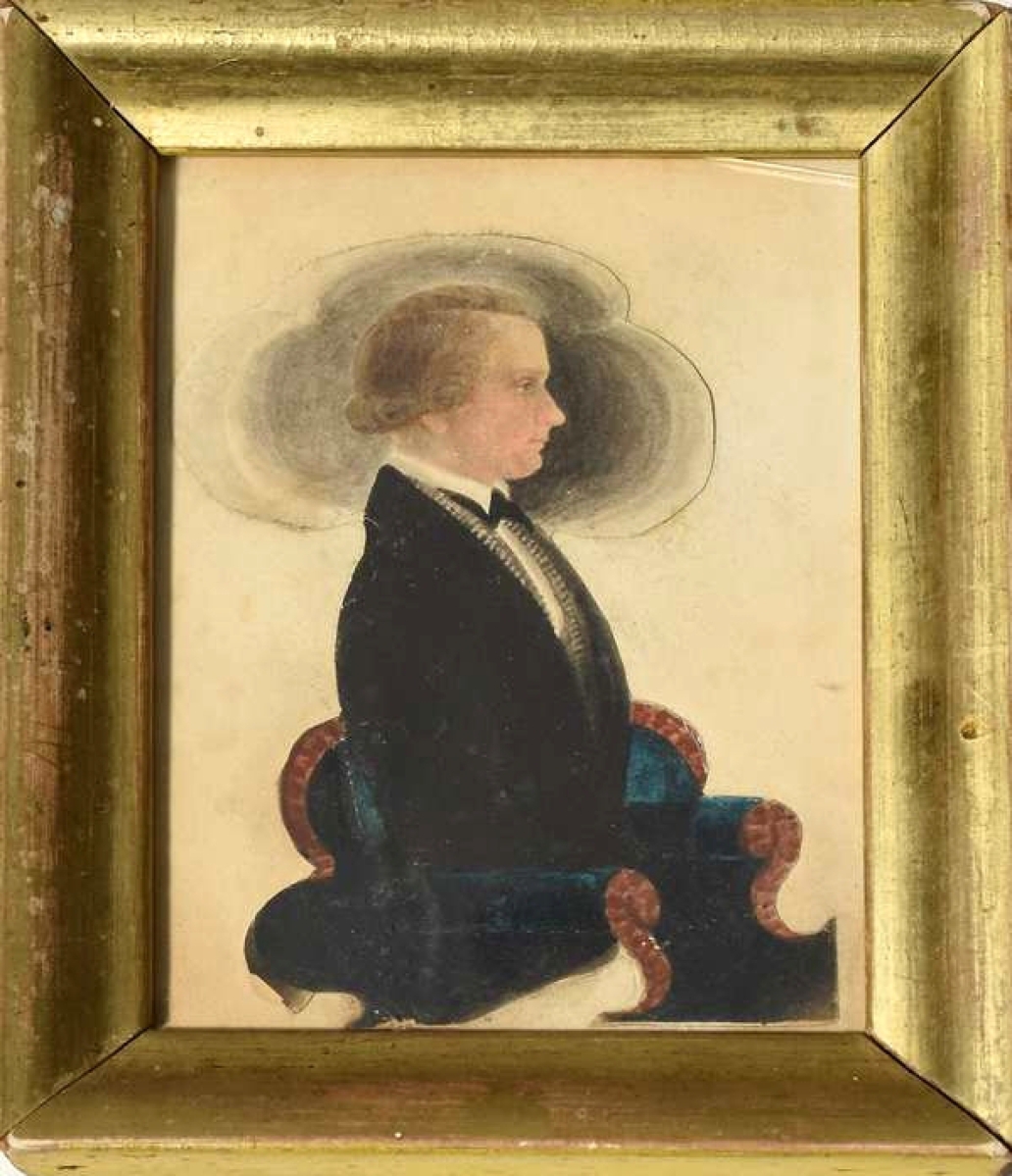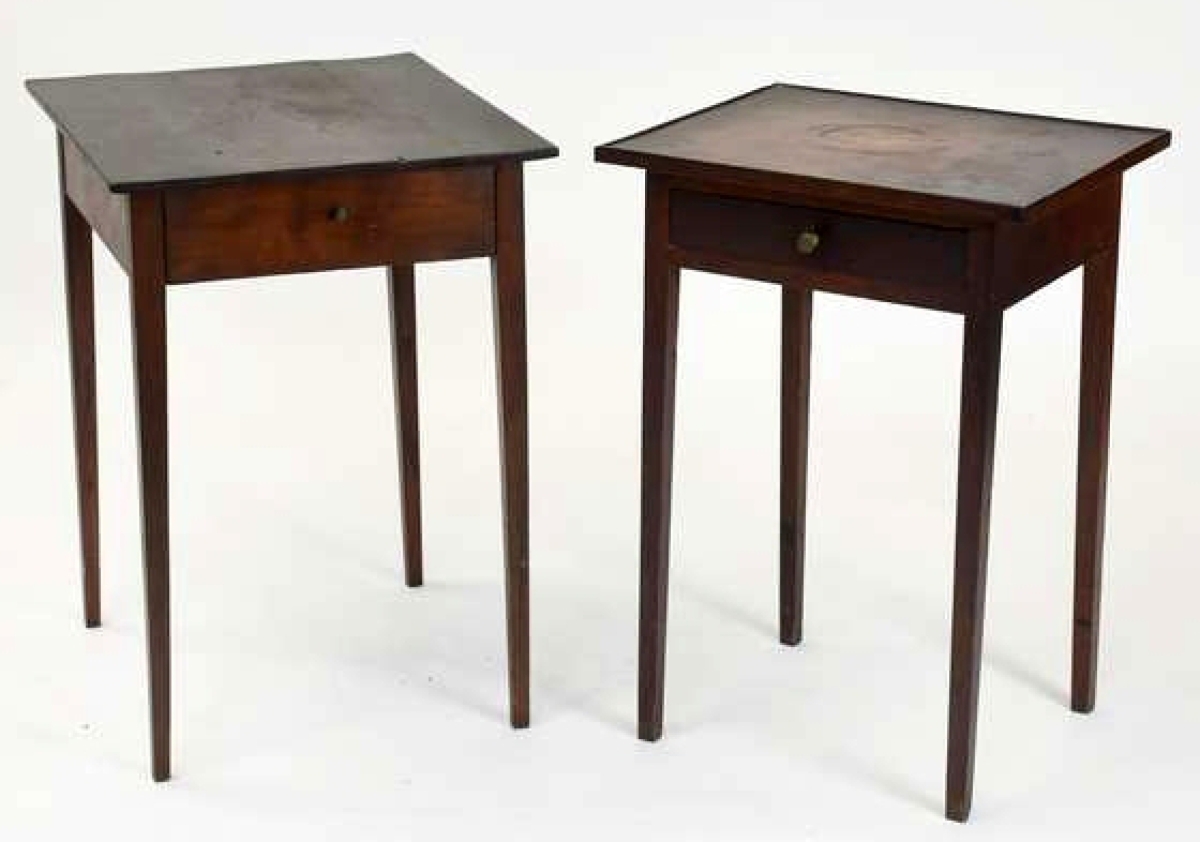
Only 186 sets of The Birds of America were printed by Robert Havell, and most of those are museums and libraries. Plate number CXI, “The Pileated Woodpecker,” was the highest priced item in the sale, realizing $23,000.
Review and Onsite Photos by Rick Russack, Additional Photos Courtesy of W.A. Smith, Inc.
PLAINFIELD, N.H. – The weather was lousy here on Labor Day, September 3, and that may have encouraged people to attend Bill Smith’s auction since it was not a day for outdoor activities. There were well over 300 in the room, more than there were chairs for, so several people were standing. The parking lot is too small for crowds like this one, and many cars were parked on the state highway in front of the gallery – on both sides of the road. Smith does not utilize online bidding, which also contributes to crowd size, but several phone lines were in use and there were numerous absentee bids. Smith makes a virtue of not using the internet, telling the crowd that it keeps their business private since prices realized are not online. Almost everything is sold without reserve, and the listings for each item on Smith’s website say that.
The sale included a number of American paintings, several by major artists, dozens of pieces of good American furniture, custom made furniture by Donald Dunlap, jewelry that did quite well, a group of four carousel horses, weathervanes, some rare Staffordshire, Asian items, clocks, early lighting devices, Audubon prints, Oriental rugs and much more.
About 15 minutes into the sale, a Federal period tall case clock made by Frederick Wingate of Augusta, Maine, dated 1821, brought $8,625 from a phone bidder. The mahogany case was inlaid with bird’s-eye maple veneer; it had fluted columns, brass finials, with a fretwork bonnet and a moon-phase dial. Wingate’s label was inside the case. Wingate was also a silversmith as well as a prolific maker of tall case clocks. Also selling early in the sale were three oil on canvas paintings of side-wheel steamboats, done by Albert Nemethy (1920-1998). He is best known for paintings like these, especially steamboats along the Hudson River. Bringing the highest price, $1,840, was his painting of the paddle wheeler Ida, which saw military service in the Confederate navy on the Savannah River in Georgia, until captured and burned by Union forces late in the war. The same buyer paid $1,725 for the Mary Powell, a side-wheeler on the Hudson River. According to Wikipedia, Nemethy was born in Hungary and remained there through World War II, finally emigrating to the United States in 1950. At first, he sold his paintings for $5 each.
Three folk portraits by Ralph D. Curtis (1808-1885) were included in the sale and were bought by Sheffield, Mass., dealer Linda Rosen. Each was on wood panels and two were the children of Sarah Thompson Gardner of Pownal, Vt. When Smith sold the first of these two, he commented that his company had sold them as a pair about 15 years ago, but at the time the artist had not been identified. Since then, research by Dr J.E. Jelinek and his wife, published in The Magazine Antiques in 2009, identified the painter and provided biographical information about him. Smith chose to sell the paintings separately. The portrait of a child in a red dress sold for $15,525. The portrait of young Theodore A. Gardner sold for $4,600, and a portrait of his mother went for $3,738. Other folky paintings did well, with an oil on canvas of the USS Plymouth, done by James Fulton Pringle (1788-1847), earning $2,990. There were many paintings by regional artists in the sale, and some were surprisingly good buys. An oil signed by Benjamin Champney (1817-1907) of Mount Kearsarge on the eastern fringe of the White Mountains went out for just $1,265.
Smith had a selection of Audubon prints of birds and mammals, from various editions and from one collection, much of which had been assembled in the 1970s. One brought the highest price in the sale. It was plate number CXI, “The Pileated Woodpecker” from the Havell edition of The Birds of America, and it sold for $23,000. The Havell edition aquatint engravings are watermarked by J. Whatman, who made the paper, and were published in the 1840s. Only 186 complete sets of that edition were printed and more than 100 of those are in museum collections, making single plates quite rare and, depending of the species illustrated, quite desirable.

Smith promoted this circa 1780-1820 Chinese silk robe in all of the firm’s advertising. That got it in front of numerous interested buyers, resulting in it selling for more than four times its high estimate. The robe was a deep blue with nine dragon roundels, and it sold for $21,850, the second highest price of the day.
Another plate from that edition, plate CCCXXVII, “The Shoveller Duck,” sold for $8,050. Plates from the Viviparous Quadrupeds of North America, which was printed between 1845 and 1848 by J.T Bowen, were also available: the “Oregon Flying Squirrel,” plate XV, sold for $403, and plate CIII, the “Hoary Marmot,” sold for $374.
Prices achieved for “brown” furniture varied. Looking like a good buy and surprising Smith, one of the first lots sold included three Eighteenth Century Queen Anne mahogany side chairs, probably from Rhode Island, which earned $403. A North Shore/Boston Federal card table with flame birch inlay and reeded legs did better, ending at $1,380. Better yet was a New Hampshire school Queen Anne maple highboy with a well-scrolled apron and fan carving, which reached $3,738.
While selling, Smith will often provide his audience with lessons on determining where a piece of furniture was made, or why it may be of particular interest. While selling a Chippendale maple oxbow four-drawer chest, he explained, “Chests from this period were made in different styles. Most often, you’ll see these chests with straight front. Bow fronts like this are less common, oxbows are less common, and the rarest form is the block front.” This oxbow realized $1,130.
Two Anglo-Indian pieces were not what the crowd wanted this time. A carved rosewood sofa, with a caned back and sides sold for just $575, and an accompanying one-drawer rosewood side table with bone and other inlays sold for $403. Smith said the consignor had paid $12,000 for the sofa. High-quality reproduction furniture continues to bring good prices, sometimes higher than the original Eighteenth Century pieces they are based on. A small, cherry Queen Anne-style highboy with a lattice work top made by the late Donald Dunlap brought $3,565.
From the same collection as the Audubon prints came four repainted carousel horses, which had been together since the 1970s. A second row stander, carved by Charles Carmel circa 1905-15, realized $4,025. A jumper made by the Philadelphia Toboggan Company, circa 1917, carved by John Zalar was, according to the catalog, one of only four produced. It had been used at the Marine Pier in Wildwood, N.J., and realized $2,875. A dappled grey jumper by Allen Herschell, circa 1920, went out for $1,265.

Smith said that he sold this primitive portrait of a child in a red dress on a wooden panel about 15 years, along with a portrait of the child’s brother. At the time, the painter had not been identified but is now known to be Ralph D. Curtis of Skaneateles, N.Y. It went to a bidder in the room for $15,525. The companion portrait brought $4,600.
Some of the Asian items were expected to do well, and one, an early Chinese blue silk dragon robe, with nine dragon roundels, brought one of the highest prices of the day, $21,850. Smith later said that it dated from about 1780-1800. A large Nineteenth Century Chinese ancestral portrait, gouache on paper, also did well, finishing at $11,788.
An assortment of jewelry came from several estates and was fresh to the market. A pair of diamond stud earrings, approximately 2 carats each, with an EGL certificate stating I clarity and F-G color, reached $11,788. There were also two pieces that each sold for $9,775; a 15-carat-weight diamond 17-inch riviere necklace set in platinum, with 77 round cut diamonds, each approximately .18-.22 carats, and a 26-inch Edwardian platinum diamond encrusted watch and chain accented with emeralds, circa 1915. It had a 1-carat. Half-moon-shaped main stone with approximately .5-carat-weight side stones (emeralds included).
After the sale, Smith said he was satisfied with the results. “We had a good crowd, and they were bidding actively. From the presale interest, I thought the Chinese robe would do well, which it did. I was pleasantly surprised at the interest in works by local artists. So, all in all, it was good day for us, and I know that stuff went out at prices that will let dealers make some money.”
Prices given include the buyer’s premium as stated by the auction house. For additional information, 603-675-2549 or www.wsmithauction.com


























